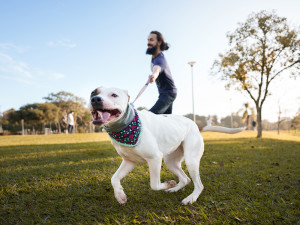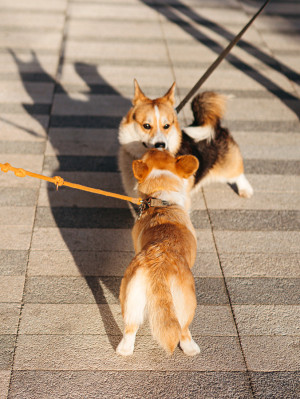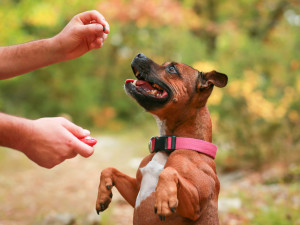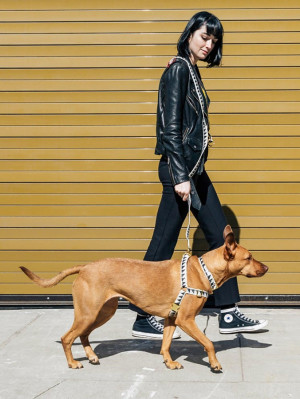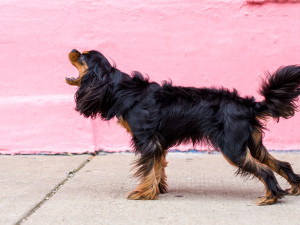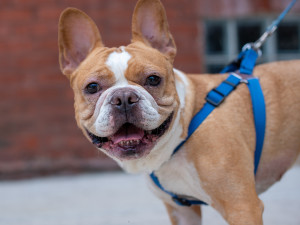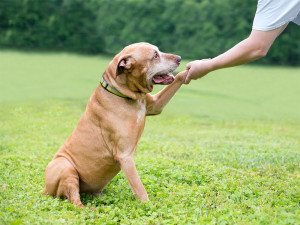The B.A.T. Dog Training Method Is What’s Up
Behavior Adjustment Training (B.A.T.) will keep your dog calm in any situation. For real.
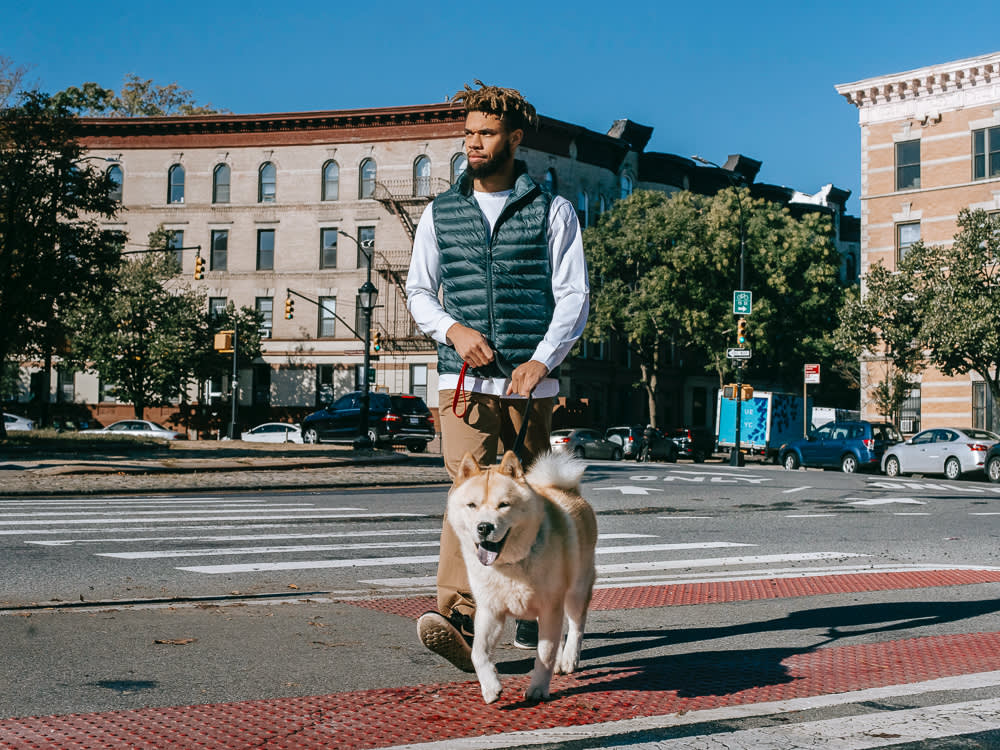
Share Article
You’re walking your dog when an off-leash Lab comes sprinting your way. You know your anxious dog is about to freak out. The Lab’s parent shouts: “Don’t worry, she’s friendly!” It’s meant to reassure you, but few phrases are more terrifying when you know your dog is going to barkopens in a new tab or lungeopens in a new tab at the pup.
What do you do? You might try correcting your dog — but it’s actually not the best time to teach them a lesson. It doesn’t make them feel any better, though they may stop growlingopens in a new tab, which is their way of letting you know they’re uncomfortable. Shutting off your dog’s warning system makes their behavior more unpredictable and, therefore, dangerous. (It’s like taking the batteries out of your smoke alarm instead of dealing with the fire.)

littleKin™ is Kinship’s home just for puppy and kitten parents. Bop over to check out expert advice, new pet tools, and special deals—all curated for your newest family member.
opens in a new tabA better idea is to use a proactive training method called Behavior Adjustment Training (B.A.T.), which helps desensitize your dog to triggers (like an energetic puppy). If your dog gets frustrated, anxiousopens in a new tab, or fearful in social situations, it’s worth giving B.A.T. a shot. Here’s primer to help you get started.
What is behavior adjustment training (B.A.T.)?
With B.A.T., you set up scenarios similar to situations that would cause a reaction from your dog but that are different enough that the dog can explore the area and learn about the trigger at their own pace. B.A.T. gives dogs a reality check. Dogs who would usually overreact have a chance to slow down and learn from experiences that contradict their negative expectations.
Here’s how that reality check works. Your dog comes into a situation expecting XYZ to happen. That means they’re ready to respond in a certain way and interpret the situation through that lens. When XYZ doesn’t happen, it creates an “expectancy violation,” which can drastically change your dog’s outlook. Carefully orchestrated positive interactions can alter the way your dog responds to triggers. For example, my dog was terrified of strangers, and B.A.T. helped him learn that people were not scary, but fun. He now solicits attention and affection from people he’s never met.
The chance to fully explore a situation and learn about a trigger is one of the biggest differences between B.A.T. and other force-free techniques. Behavior exists to have an effect, and having effective behavioral strategies is one of the basic needs of all animals. Giving your dog control over stressors has a range of benefits, including better concentration and improved social skills, a healthier immune system, and resilience to stress.
B.A.T. training set-ups are situations that a dog can manage without significant help. We can maximize empowerment by putting treats away and following the dog as they explore. Following your dog may contradict everything you’ve learned about training. You may have heard that you have to be a dominant leader, or that you and your treatsopens in a new tab have to be the center of your dog’s universe. B.A.T. has a different approach, and it works.
The Three Components of B.A.T.
B.A.T.’s emphasis is on empowerment — on teaching dogs that they can use behavior to control their own safety.
1. Leash Skills
You’ll learn specific ways you can handle a long leash so your dog can move about freely and still be under control for safety. B.A.T. leash skills can be used with all dogs and puppies for socialization and to reduce pulling. There are about 10 leash skills to practice, including ways to shorten the line without tangling it, stay out of your dog’s way, hold the leash so you can’t accidentally let go, get your dog’s attention with soft strokes on the leash, and gently bring your dog to a stop.
For example, you can use the “slow stop” technique to keep your dog from getting too close to a trigger before they’re ready. To do a slow stop, gradually slow your walking and gently squeeze on the leash, letting some slide through. Think of it as gradually depressing a car’s brake pedal. If your dog suddenly slams to a stop, they’re more likely to overreact to the trigger than if they are slowly brought to a halt. After you stop your dog, relax the leash a little bit so they’re not restrained. (There are several more leash skills, each with a specific function.)
2. Survival Skills
They’re not the main point of B.A.T., but they keep your dog from having a bad experience that may set back training. They’re what you use to get through situations that your dog can’t handle yet. For example, if you’re walking down the street with your dog (who often barks at children) and you see a child coming toward you, you could: cross the street, walk in an arc around the child, or cue your dog to look at you and/or feed treats as the two of you pass by. There are many ways to help your dog cope with trouble when they’re not ready to do it on their own.
One B.A.T. survival skill is called “mark and move,” where you use some sort of marker signal — say, a clickeropens in a new tab — to pinpoint a behavior, like noticing the trigger, sniffing the trigger, blinking, or turning away. After marking, you encourage your dog to move away and then give them a reinforcer, such as a treat or a toy. Mark and move is basically just clicker training with movement, and is used for surprises on walks or when your dog first greets a trigger in the early stages of training.
Most people don’t want to use treats forever to keep their dog calm, and the good news is, you won’t have to. When you do enough of the training set-ups, your dog will start to handle more situations on their own. B.A.T. set-ups build a solid communication system with your dog so if they ever need your help, you’ll know.
3. B.A.T. Set-Ups
These are safe scenarios where your dog can socialize naturally and interact with triggers in positive ways. I recommend doing your first sessions with a Certified B.A.T. Instructor or other experienced professional traineropens in a new tab. The example that follows will give you a taste of what B.A.T. looks like, but it’s better to know the full technique before using it.
Let’s say your dog’s main issue is that he barks at children from 25 feet away. In a B.A.T. set-up with your friend’s child, your dog would ideally be wearing a harnessopens in a new tab and be on a 15-foot leash. The child could sit at a picnic table with her mom at the far end of a park, say, 100 feet away from you. You and the other adult(s) have phones so you can communicate with one another during the exercise. If you think there’s any risk of your dog biting, have a barrier around the child or pre-train your dog to wear a muzzle.
Follow your dog casually as they walk around. At some point, your dog might notice the child and go back to sniffing. Simply follow, letting out the leash when needed, then catching up and shortening it again. Let your dog choose the route, resisting the temptation to lead your dog toward the child. To someone watching, it would look like your dog is looking for a place to pee, or maybe sniffing out squirrels — like a dog exploring the area, with an occasional interest in the child.
As your dog wanders, they may stay relaxed but gradually move closer to the child, which is great. If your dog starts to really focus on the child, perhaps by walking in a straight line toward her, do a slow stop and relax the leash. You could also walk at an angle that leads your dog away from the child and then stop, waiting for your dog to turn away. Keep the leash loose and don’t call your dog unless your dog is really having trouble. If you need to frequently redirect your dog, you may be too close, or the working environment may not encourage enough exploration. There are more details, but that’s the general idea.
B.A.T. is kind of boring, actually, and that’s a good thing. Couldn’t you use a little less drama on your walks?
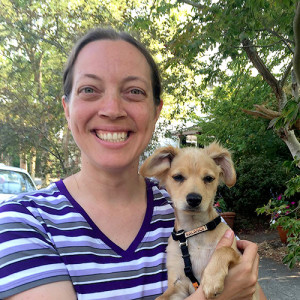
Grisha Stewart, MA, CPDT-KA
Grisha Stewart is an author, international speaker and dog trainer specializing in reactivity and empowered socialization. Her books include The Official Ahimsa Dog Training Manual:
A Practical, Force-Free Guide to Problem Solving & Manners and Behavior Adjustment Training 2.0: New Practical Techniques for Fear, Frustration, and Aggression in Dogs.
Related articles
![Boston terrier being stubborn]() opens in a new tab
opens in a new tabDog Training — DIY or Hire a Pro?
When it’s time to call in reinforcements.
![Dog barking on the sidewalk in front of a pink wall]() opens in a new tab
opens in a new tabHow to Fix Your Dog’s Non-Stop Barking
You can live in a quiet house again.
![French bulldog smiling with blue harness]() opens in a new tab
opens in a new tabStrap in: Dog Collars vs. Harnesses
Style and safety don’t have to be mutually exclusive (phew).
![A senior Retriever/Terrier mixed breed dog shaking hands with its owner.]() opens in a new tab
opens in a new tabHow to Teach an Old Dog New Tricks
Your senior dog might move slower these days, but that doesn’t mean they can’t learn new things.
![Dog lying on a brick street with a leash]() opens in a new tab
opens in a new tab“Why Won’t My Dog Walk Outside?”
Dog behaviorist Karen B. London’s 7 tips to help get your parked pet moving.
![Dog walker walking with her pet on leash on the sidewalk]() opens in a new tab
opens in a new tab10 Tips You’ll Definitely Want to Follow When You Walk Your Dog
From the safest gear to training recs.

